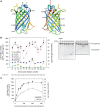Cell-free co-production of an orthogonal transfer RNA activates efficient site-specific non-natural amino acid incorporation
- PMID: 23589624
- PMCID: PMC3675464
- DOI: 10.1093/nar/gkt226
Cell-free co-production of an orthogonal transfer RNA activates efficient site-specific non-natural amino acid incorporation
Abstract
We describe a new cell-free protein synthesis (CFPS) method for site-specific incorporation of non-natural amino acids (nnAAs) into proteins in which the orthogonal tRNA (o-tRNA) and the modified protein (i.e. the protein containing the nnAA) are produced simultaneously. Using this method, 0.9-1.7 mg/ml of modified soluble super-folder green fluorescent protein (sfGFP) containing either p-azido-l-phenylalanine (pAzF) or p-propargyloxy-l-phenylalanine (pPaF) accumulated in the CFPS solutions; these yields correspond to 50-88% suppression efficiency. The o-tRNA can be transcribed either from a linearized plasmid or from a crude PCR product. Comparison of two different o-tRNAs suggests that the new platform is not limited by Ef-Tu recognition of the acylated o-tRNA at sufficiently high o-tRNA template concentrations. Analysis of nnAA incorporation across 12 different sites in sfGFP suggests that modified protein yields and suppression efficiencies (i.e. the position effect) do not correlate with any of the reported trends. Sites that were ineffectively suppressed with the original o-tRNA were better suppressed with an optimized o-tRNA (o-tRNA(opt)) that was evolved to be better recognized by Ef-Tu. This new platform can also be used to screen scissile ribozymes for improved catalysis.
Figures






References
-
- Cornish VW, Mendel D, Schultz PG. Probing protein structure and function with an expanded genetic code. Angew. Chem. Int. Ed. Engl. 1995;34:621–633.
-
- Ellman J, Mendel D, Anthony-Cahill S, Noren CJ, Schultz PG. Biosynthetic method for introducing unnatural amino acids site-specifically into proteins. Methods Enzymol. 1991;202:301–336. - PubMed
-
- Bonnefond L, Giegé R, Rudinger-Thirion J. Evolution of the tRNA(Tyr)/TyrRS aminoacylation systems. Biochimie. 2005;87:873–883. - PubMed
-
- Kobayashi T, Nureki O, Ishitani R, Yaremchuk A, Tukalo M, Cusack S, Sakamoto K, Yokoyama S. Structural basis for orthogonal tRNA specificities of tyrosyl-tRNA synthetases for genetic code expansion. Nat. Struct. Biol. 2003;10:425–432. - PubMed
-
- Wang L, Schultz PG. A general approach for the generation of orthogonal tRNAs. Chem. Biol. 2001;8:883–890. - PubMed
Publication types
MeSH terms
Substances
Grants and funding
LinkOut - more resources
Full Text Sources
Other Literature Sources

